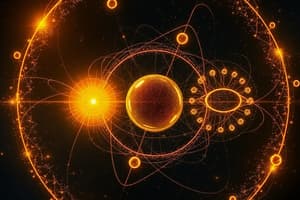Podcast
Questions and Answers
What is the atomic number of an atom equivalent to?
What is the atomic number of an atom equivalent to?
- Number of neutrons
- Sum of protons and neutrons
- Number of electrons minus neutrons
- Number of protons (correct)
How is the mass number of an atom calculated?
How is the mass number of an atom calculated?
- Total number of protons only
- Number of electrons plus neutrons
- Sum of protons and neutrons (correct)
- Number of protons minus electrons
If an element has an atomic number of 14, how many electrons does it have?
If an element has an atomic number of 14, how many electrons does it have?
- 14 (correct)
- 28
- 7
- 21
Which of the following statements about ions is correct?
Which of the following statements about ions is correct?
In the provided table, what is the mass number of an element with 55 protons and 25 neutrons?
In the provided table, what is the mass number of an element with 55 protons and 25 neutrons?
What is indicated by the term 'neutral particles' in relation to atoms and molecules?
What is indicated by the term 'neutral particles' in relation to atoms and molecules?
Which postulate of Dalton's atomic model states that all atoms of the same element are identical?
Which postulate of Dalton's atomic model states that all atoms of the same element are identical?
What does the law of conservation of mass state?
What does the law of conservation of mass state?
What significant finding emerged from Rutherford's gold foil experiment?
What significant finding emerged from Rutherford's gold foil experiment?
Which particle was discovered by Eugen Goldstein in 1886?
Which particle was discovered by Eugen Goldstein in 1886?
Who is credited with the discovery of neutrons?
Who is credited with the discovery of neutrons?
What is the central idea behind the law of multiple proportions?
What is the central idea behind the law of multiple proportions?
Which atomic model proposed that negatively-charged electrons are embedded in a positively-charged 'soup'?
Which atomic model proposed that negatively-charged electrons are embedded in a positively-charged 'soup'?
In Dalton's atomic model, how are atoms described?
In Dalton's atomic model, how are atoms described?
Study Notes
John Dalton’s Atomic Model
- Introduced in 1803 as a theory of chemical combination.
- Postulates:
- Elements are made of indivisible particles called atoms.
- Atoms of the same element are identical; different elements have different atoms.
- Atoms cannot be created or destroyed.
Scientific Laws
- Law of Conservation of Mass: Matter cannot be created or destroyed.
- Law of Definite Proportions: A given chemical compound contains the same elements in the same mass proportions.
- Law of Multiple Proportions: If two elements form multiple compounds, the mass ratios of one element that combine with a fixed mass of the second element are rational numbers.
Subatomic Particles
- Atoms are the smallest unit of an element retaining its properties.
- Atoms consist of subatomic particles:
- Protons (positively charged)
- Electrons (negatively charged)
- Neutrons (neutral)
History of Atomic Structure
- Thomson’s Plum Pudding Model: Described atoms as a positively charged "soup" with negatively charged electrons embedded.
- Rutherford’s Gold Foil Experiment: Demonstrated that atoms are mostly empty space with a dense, positively charged nucleus.
Discovery of Protons
- Eugen Goldstein (1886) observed bright rays from the anode of a cathode tube, identifying them as streams of positively charged particles known as protons.
Discovery of Neutrons
- James Chadwick discovered neutrons in 1932 by firing alpha radiation at beryllium, producing uncharged radiation detected in paraffin wax.
Atoms, Molecules, and Ions
- Atoms: Single neutral particles.
- Molecules: Neutral particles composed of two or more bonded atoms.
- Ions: Charged particles (either positively or negatively).
Atomic Number and Mass Number
- Atomic Number: Represents the number of protons in an atom's nucleus; also equal to the number of electrons.
- Mass Number: Total of protons and neutrons in the nucleus.
- Calculated as: Mass Number = Number of Protons + Number of Neutrons.
- Number of Neutrons = Mass Number - Number of Protons.
Example Elements Summary
- Oxygen (O): Mass number 16, atomic number 8, 8 protons, 8 electrons, 8 neutrons.
- Silicon (Si): Mass number 28, atomic number 14, 14 protons, 14 electrons, 14 neutrons.
- Nitrogen (N): Mass number 14, atomic number 7, 7 protons, 7 electrons, 7 neutrons.
Studying That Suits You
Use AI to generate personalized quizzes and flashcards to suit your learning preferences.
Related Documents
Description
This quiz covers Lesson 2 on Atoms, Molecules, and Ions, focusing on John Dalton's Atomic Model and its key postulates. Explore the foundational concepts of chemical combination and the essential laws of conservation of mass and definite proportions. Test your understanding of these important principles in chemistry.




